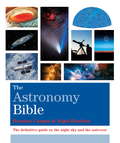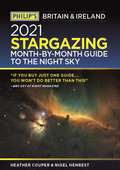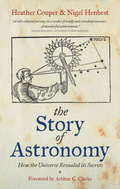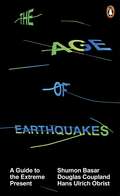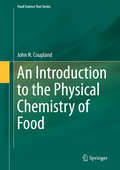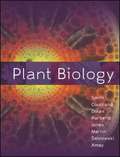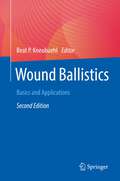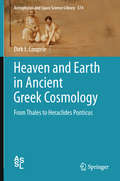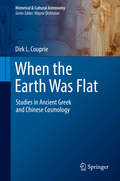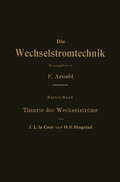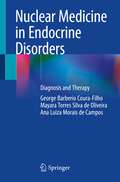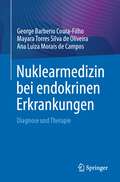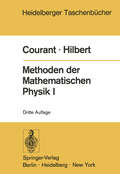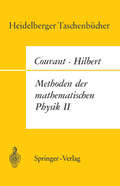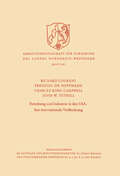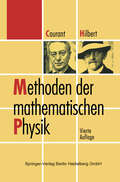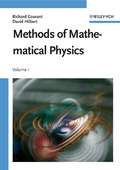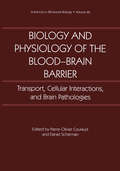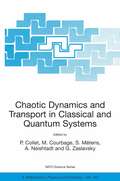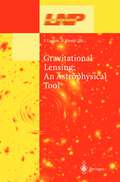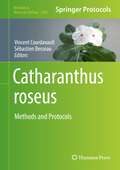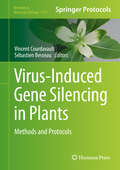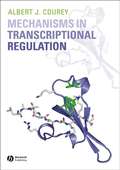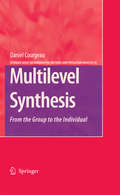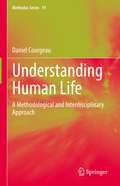- Table View
- List View
The Astronomy Bible: The Definitive Guide To The Night Sky And The Universe (Subject Bible Ser.)
by Heather Couper Nigel HenbestThis comprehensive guide to astronomy introduces the basic concepts, explaining what, when, and how to observe space, right through to current theories on everything from black holes to microquasars. It helps you to navigate the night sky, identify the constellations and find planets, comets, galaxies and deep-sky objects.Accessible, informative, and fully-illustrated, this is an invaluable practical companion for anyone who loves stargazing.
Philip's Stargazing Month-by-Month Guide to the Night Sky Britain & Ireland (Philip's Stargazing)
by Heather Couper Nigel Henbest"IF YOU BUY JUST ONE GUIDE... YOU WON'T DO BETTER THAN THIS" BBC Sky at Night Magazine"I WILL CONTINUE TO ENJOY 'STARGAZING' AS THE MONTHS GO BY" Helen Sharman, Astronaut "VERY USEFUL INDEED" Chris Lintott, Sky at Night presenterDiscover the latest in star gazing with the new and definitive guide to the night sky.Whether you're a seasoned astronomer or just starting out, Philip's Stargazing 2021 is the only book you'll need. Compiled by experts and specially designed for use in Britain and Ireland, Stargazing 2021 acts as a handily illustrated and comprehensive companion.- 12 Brand-New Maps for year-round astronomical discovery- Month-to-Month informationDaily Moon Phase Calendar, highlighting special lunar events throughout the year- Planet Watch for ideal viewing days in 2021- Avoid light pollution with our detailed Dark Sky Map- Expert advice and insight throughout from internationally renowned Professors Couper and Henbest- Using Binoculars - Stargazing recommendations from expert Robin Scagell- Perfect for home use during lockdown- Complete calendar of major astronomical events, including the Top 20 Sky Sights of 2021- Jargon Buster, explaining common or confusing terms - The planets' movements explained from solar and lunar eclipses to meteor showers and comets
The Story of Astronomy: How the universe revealed its secrets
by Heather Couper Nigel HenbestJourney through time and space with the greatest astronomers in history. Astronomy is one of the oldest of all the sciences. And yet, its history is also so much more than the history of a science, reflecting our entire culture and providing insight into the evolution of humankind's ideas and ideals over the centuries. This fascinating book tells the amazing story of the development of astronomy, through the key characters in its history from Copernicus to Hubble and Halley, the excitement of new discoveries and the ways in which the history of the skies has affected our lives and how we look at the planet on which we live.The Story of Astronomy celebrates changing perspectives (from the Ancient Greeks to the latest scientific advances) as different cultures, philosophers and scientists sought to come to terms with their, and earth's, place in the Cosmos.Exhaustively researched and containing interviews with many of the world's leading astronomers, including Stephen Hawking, this is the ultimate history of how the universe has revealed itself to us over the millennia.
The Age of Earthquakes: A Guide to the Extreme Present
by Douglas Coupland Hans Ulrich Obrist Shumon BasarPlanet Earth needs a self-help book, and this is itThe future is happening to us far faster than we thought it would and this book explains whyFifty years after Marshall McLuhan's ground breaking book on the influence of technology on culture The Medium is the Massage, Shumon Basar, Douglas Coupland and Hans Ulrich Obrist extend the analysis to today, touring the world that's redefined by the Internet, decoding and explaining what they call the 'extreme present'.The Age of Earthquakes is a quick-fire paperback, harnessing the images, language and perceptions of our unfurling digital lives. The authors invent a glossary of new words to describe how we are truly feeling today; and 'mindsource' images and illustrations from over 30 contemporary artists. Wayne Daly's striking graphic design imports the surreal, juxtaposed, mashed mannerisms of screen to page. It's like a culturally prescient, all-knowing email to the reader: possibly the best email they will ever read.Welcome to The Age of Earthquakes, a paper portrait of Now, where the Internet hasn't just changed the structure of our brains these past few years, it's also changing the structure of the planet. This is a new history of the world that fits perfectly in your back pocket.
An Introduction to the Physical Chemistry of Food (Food Science Text Series)
by John N. CouplandFamiliar combinations of ingredients and processing make the structures that give food its properties. For example in ice cream, the emulsifiers and proteins stabilize partly crystalline milk fat as an emulsion, freezing (crystallization) of some of the water gives the product its hardness and polysaccharide stabilizers keep it smooth. Why different recipes work as they do is largely governed by the rules of physical chemistry.This textbook introduces the physical chemistry essential to understanding the behavior of foods. Starting with the simplest model of molecules attracting and repelling one another while being moved by the randomizing effect of heat, the laws of thermodynamics are used to derive important properties of foods such as flavor binding and water activity. Most foods contain multiple phases and the same molecular model is used to understand phase diagrams, phase separation and the properties of surfaces. The remaining chapters focus on the formation and properties of specific structures in foods – crystals, polymers, dispersions and gels.Only a basic understanding of food science is needed, and no mathematics or chemistry beyond the introductory college courses is required. At all stages, examples from the primary literature are used to illustrate the text and to highlight the practical applications of physical chemistry in food science.
Plant Biology (PDF)
by Justine Coupland DolanPlant Biology is a new textbook written for upper-level undergraduate and graduate students. It is an account of modern plant science, reflecting recent advances in genetics and genomics and the excitement they have created. The book begins with a review of what is known about the origins of modern-day plants. Next, the special features of plant genomes and genetics are explored. Subsequent chapters provide information on our current understanding of plant cell biology, plant metabolism, and plant developmental biology, with the remaining three chapters outlining the interactions of plants with their environments. The final chapter discusses the relationship of plants with humans: domestication, agriculture and crop breeding. Plant Biology contains over 1,000 full color illustrations, and each chapter begins with Learning Objectives and concludes with a Summary.
Wound Ballistics: Basics and Applications
by Robin M. Coupland Michael Thali Markus A. RothschildThe definitive interdisciplinary reference work for wound ballistics Basics The book begins by providing the necessary basic knowledge about physics, ballistics and ammunition and weapons. Then it describes the behaviour of projectiles in humans and animals (the physics of gunshot injuries) and introduces the experimental simulation of gunshot wounds, including the materials suitable for this purpose. Applications These basic principles can be applied in forensic medicine and criminalistics. The gunshot wound provides some forensic traces and the experimental reconstruction helps to understand the dynamic crime process. The wounding potential of non-lethal weapons can be determined. In emergency and war surgery, injuries caused by small arms bullets and fragments as well as by gas jets (of gas weapons) can be assessed. International conventions could be freed from undefined terms (such as “unnecessary suffering”) with the help of physical quantities. Reference work Detailed tables as e. g. ballistic data of numerous cartridge types, also older ones, material properties, as well as many otherwise difficult to access data and a trilingual glossary of ballistic and technical terms in the languages German, English and French. NEW Wound Ballistics of European Police ammunition References to recent research results Partly coloured illustrations Due to the increase in terrorist and criminal activities worldwide, it is not only members of the armed forces who are affected. Surgeons, forensic doctors, police officers and criminalists also need to know and be able to assess the specifics of gunshot wounds.
Heaven and Earth in Ancient Greek Cosmology: From Thales to Heraclides Ponticus (Astrophysics and Space Science Library #374)
by Dirk L. CouprieIn Miletus, about 550 B.C., together with our world-picture cosmology was born. This book tells the story. In Part One the reader is introduced in the archaic world-picture of a flat earth with the cupola of the celestial vault onto which the celestial bodies are attached. One of the subjects treated in that context is the riddle of the tilted celestial axis. This part also contains an extensive chapter on archaic astronomical instruments. Part Two shows how Anaximander (610-547 B.C.) blew up this archaic world-picture and replaced it by a new one that is essentially still ours. He taught that the celestial bodies orbit at different distances and that the earth floats unsupported in space. This makes him the founding father of cosmology. Part Three discusses topics that completed the new picture described by Anaximander. Special attention is paid to the confrontation between Anaxagoras and Aristotle on the question whether the earth is flat or spherical, and on the battle between Aristotle and Heraclides Ponticus on the question whether the universe is finite or infinite.
When the Earth Was Flat: Studies in Ancient Greek and Chinese Cosmology (Historical & Cultural Astronomy)
by Dirk L. CouprieThis book is a sequel to Heaven and Earth in Ancient Greek Cosmology (Springer 2011). With the help of many pictures, the reader is introduced into the way of thinking of ancient believers in a flat earth. The first part offers new interpretations of several Presocratic cosmologists and a critical discussion of Aristotle’s proofs that the earth is spherical. The second part explains and discusses the ancient Chinese system called gai tian. The last chapter shows that, inadvertently, ancient arguments and ideas return in the curious modern flat earth cosmologies.
Theorie der Wechselströme (Die Wechselstromtechnik #1)
by J.L. la Cour O.S. BragstadDieser Buchtitel ist Teil des Digitalisierungsprojekts Springer Book Archives mit Publikationen, die seit den Anfängen des Verlags von 1842 erschienen sind. Der Verlag stellt mit diesem Archiv Quellen für die historische wie auch die disziplingeschichtliche Forschung zur Verfügung, die jeweils im historischen Kontext betrachtet werden müssen. Dieser Titel erschien in der Zeit vor 1945 und wird daher in seiner zeittypischen politisch-ideologischen Ausrichtung vom Verlag nicht beworben.
Nuclear Medicine in Endocrine Disorders: Diagnosis and Therapy
by George Barberio Coura-Filho Mayara Torres Silva de Oliveira Ana Luiza Morais de CamposThis book presents up-to-date information on the general principles of diagnostic and therapeutic nuclear medicine in the context of endocrinology. The content is divided into six parts. Section I examines general aspects of radiopharmaceuticals, scintigraphy, single-photon emission computed tomography (SPECT), positron emission tomography (PET), radionuclide therapies and radioguided surgery. Section II discusses diagnostic applications in benign thyroid diseases and evaluation of thyroid nodules. Section III gives an overview of the management of parathyroid diseases. Section IV presents diagnostic techniques in well-differentiated thyroid cancer. Section V addresses procedures and therapy in adrenal benign and malignant disorders (phaechromocytomas and paragangliomas). Lastly, the diagnosis and treatment of neuroendocrine tumors are featured in Section VI. Nuclear Medicine in Endocrine Disorders: Diagnosis and Therapy is intended for non-specialists in nuclear medicine working in the field of endocrinology, and is also a valuable resource for researchers and students.
Nuklearmedizin bei endokrinen Erkrankungen: Diagnose und Therapie
by George Barberio Coura-Filho Mayara Torres Silva de Oliveira Ana Luiza Morais de CamposDieses Buch enthält aktuelle Informationen über die allgemeinen Grundsätze der diagnostischen und therapeutischen Nuklearmedizin im Kontext der Endokrinologie.Der Inhalt ist in sechs Teile gegliedert. In Abschnitt I werden allgemeine Aspekte der Radiopharmaka, der Szintigraphie, der Single-Photon-Emissions-Computertomographie (SPECT), der Positronen-Emissions-Tomographie (PET), der Radionuklidtherapien und der strahlengesteuerten Chirurgie behandelt. Abschnitt II befasst sich mit diagnostischen Anwendungen bei gutartigen Schilddrüsenerkrankungen und der Beurteilung von Schilddrüsenknoten. Abschnitt III gibt einen Überblick über die Behandlung von Nebenschilddrüsenerkrankungen. In Abschnitt IV werden diagnostische Verfahren bei gut differenziertem Schilddrüsenkrebs vorgestellt. Abschnitt V befasst sich mit Verfahren und Therapie bei gut- und bösartigen Erkrankungen der Nebenniere (Phäochromozytome und Paragangliome). Schließlich werden in Abschnitt VI die Diagnose und Behandlung neuroendokriner Tumoren vorgestellt.Nuklearmedizin bei endokrinen Erkrankungen: Diagnose und Therapie richtet sich an nicht spezialisierte Nuklearmediziner, die auf dem Gebiet der Endokrinologie arbeiten, und ist auch für Forscher und Studenten eine wertvolle Ressource.
Methoden der Mathematischen Physik I (Heidelberger Taschenbücher #30)
by R. Courant D. HilbertDieser Buchtitel ist Teil des Digitalisierungsprojekts Springer Book Archives mit Publikationen, die seit den Anfängen des Verlags von 1842 erschienen sind. Der Verlag stellt mit diesem Archiv Quellen für die historische wie auch die disziplingeschichtliche Forschung zur Verfügung, die jeweils im historischen Kontext betrachtet werden müssen. Dieser Titel erschien in der Zeit vor 1945 und wird daher in seiner zeittypischen politisch-ideologischen Ausrichtung vom Verlag nicht beworben.
Methoden der Mathematischen Physik II (Heidelberger Taschenbücher #31)
by R. Courant D. HilbertVIII über den Inhalt im einzelnen unterrichtet das ausführliche Ver zeichnis. Zur Form ist etwas Grundsätzliches zu sagen: Das klassische Ideal einer gewissermaßen atomistischen Auffassung der Mathematik ver langt, den Stoff in Form von Voraussetzungen, Sätzen und Beweisen zu kondensieren. Dabei ist der innere Zusammenhang und die Motivierung der Theorie nicht unmittelbar Gegenstand der Darstellung. In kom plementärer Weise kann man ein mathematisches Gebiet als stetiges Gewebe von Zusammenhängen betrachten, bei dessen Beschreibung die Methode und die Motivierung in den Vordergrund treten und die Kri stallisierung der Einsichten in isolierte scharf umrissene Sätze erst eine sekundäre Rolle spielt. Wo eine Synthese beider Auffassungen untunlich schien, habe ich den zweiten Gesichtspunkt bevorzugt. New Rochelle, New York, 24. Oktober 1937. R. Courant. Inhaltsverzeichnis. Erstes Kapitel. Vorbereitung. - Grundbegriffe. § I. Orientierung über die Mannigfaltigkeit der Lösungen 2 1. Beispiele S. 2. - 2. Differentialgleichungen zu gegebenen Funk tionenscharen und -familien S. 7. § 2. Systeme von Differentialgleichungen ............... 10 1. Problem der Äquivalenz von Systemen und einzelnen Differential 2. Bestimmte, überbestimmte, unterbestimmte gleichungen S. 10. - Systeme S. 12. § J. Integrationsmethoden bei speziellen Differentialgleichungen. . . . . . 14 1. Separation der Variablen S. 14. - 2. Erzeugung weiterer Lösungen durch Superposition. Grundlösung der Wärmeleitung. Poissons Integral S.16. § 4. Geometrische Deutung einer partiellen Differentialgleichung erster Ord nung mit zwei unabhängigen Variablen. Das vollständige Integral . . 18 1. Die geometrische Deutung einer partiellen Differentialgleichung erster Ordnung S. 18. - 2. Das vollständige Integral S. 19. - 3. Singuläre Integrale S. 20.
Forschung und Industrie in den USA - ihre internationale Verflechtung (Arbeitsgemeinschaft für Forschung des Landes Nordrhein-Westfalen #107)
by Richard CourantMethoden der mathematischen Physik
by Richard Courant David HilbertIn diesem Buch spürt man noch immer die Inspiration zweier großer Mathematiker: Hilbert gilt als der letzte seiner Zunft, der in allen Gebieten der Mathematik zu Hause war. Seine grundlegend neuen Erkenntnisse prägten entscheidend die moderne Auffassung vom Wesen der Mathematik. Sein Schüler Courant ist auch heute noch anerkannt als ein ausgezeichneter Lehrer, der die Gabe hatte, schwierigste Materien verständlich darstellen zu können.
Methods of Mathematical Physics
by Richard Courant David HilbertSince the first volume of this work came out in Germany in 1924, this book, together with its second volume, has remained standard in the field. Courant and Hilbert's treatment restores the historically deep connections between physical intuition and mathematical development, providing the reader with a unified approach to mathematical physics. The present volume represents Richard Courant's second and final revision of 1953.
Biology and Physiology of the Blood-Brain Barrier: Transport, Cellular Interactions, and Brain Pathologies (Advances in Behavioral Biology #46)
by Pierre-Olivier Couraud Daniel SchermanThe endothelial cells of the cerebral vasculature constitute, together with perivascular elements (astrocytes, pcricytes, basement membrane), the blood-brain barrier (BBB), which strictly limits and specifically controls the exchanges between the blood and the cerebral extracellular spacc.The existence of such a physical, enzymatic, and active barrier isolating the central nervous system has broad physiological, biological, pharmacological, and patho logical consequences, most of which are not yet fully elucidated. The Cerebral Vascular Biology conference (CVB '95) was organized and held at the "Carre des Sciences" in Paris on July I 0-12, 1995. Like the CVB '92 conference held in Duluth, Minnesota, three years ago, the objectives were to provide a forum for presentation of the most recent progresses and to stimulate discussions in the ticld of the biology, physiology. and pathology of the blood-brain barrier. The Paris conference gathered more than !50 participants. including investigators in basic neuroscience, physicians. and stu dents, who actively contributed to the scientific program by their oral or poster presentations. This volume contains a collection of short articles that summarize most of the new data that were presented at the conference. Six thematic parts focus on physiological transports. drug delivery, multidrug resistance P-glycoprotein, signal transduction at the BBB. interactions between the immune system and the cerebral endothelial cells, and the blood-brain barrier-related pathologies in the central nervous system. In addition, two introductory articles present new insights in the rapidly evolving topics of cerebral angiogenesis and gene transfer to the brain.
Chaotic Dynamics and Transport in Classical and Quantum Systems: Proceedings of the NATO Advanced Study Institute on International Summer School on Chaotic Dynamics and Transport in Classical and Quantum Systems, Cargèse, Corsica, 18 - 30 August 2003. (NATO Science Series II: Mathematics, Physics and Chemistry #182)
by M. Courbage S. Métens A. Neishtadt G. Zaslavsky Pierre ColletFrom the 18th to the 30th August 2003 , a NATO Advanced Study Institute (ASI) was held in Cargèse, Corsica, France. Cargèse is a nice small village situated by the mediterranean sea and the Institut d'Etudes Scientifiques de Cargese provides ? a traditional place to organize Theoretical Physics Summer Schools and Workshops * in a closed and well equiped place. The ASI was an International Summer School on "Chaotic Dynamics and Transport in Classical and Quantum Systems". The main goal of the school was to develop the mutual interaction between Physics and Mathematics concerning statistical properties of classical and quantum dynamical systems. Various experimental and numerical observations have shown new phenomena of chaotic and anomalous transport, fractal structures, chaos in physics accelerators and in cooled atoms inside atom-optics billiards, space-time chaos, fluctuations far from equilibrium, quantum decoherence etc. New theoretical methods have been developed in order to modelize and to understand these phenomena (volume preserving and ergodic dynamical systems, non-equilibrium statistical dynamics, fractional kinetics, coupled maps, space-time entropy, quantum dissipative processes etc). The school gathered a team of specialists from several horizons lecturing and discussing on the achievements, perspectives and open problems (both fundamental and applied).
Gravitational Lensing: An Astrophysical Tool (Lecture Notes in Physics #608)
by Frédéric Courbin Dante MinnitiGravitational lensing is by now sufficiently well understood that it can be used as a tool of investigation in other astrophysical areas. Applications include the determination of the Hubble constant, probing the dark matter context of galaxies and the mapping of the universe to the identification of otherwise invisible large-scale structures. Each chapter of the book covers in a self-contained manner a subfield of gravitational lensing, with the double aim of describing in a simple way the basics of the theory and of reviewing the most recent developments as well as applications foreseen in the near future. The book will thus be particularly useful as a high-level textbook for nonspecialist researchers and advanced students wishing to become familiar with the field all the way up to the forefront of research.
Catharanthus roseus: Methods and Protocols (Methods in Molecular Biology #2505)
by Vincent Courdavault Sébastien BesseauThis volume provides updated technical approaches that have been developed to characterize monoterpene indole alkaloid metabolism in C. roseus from metabolite/gene product localization, alkaloid chemical synthesis, candidate gene prediction, transcription factor characterization up to functional genomic tools based on gene overexpression. Written in the format of the highly successful Methods in Molecular Biology series, each chapter includes an introduction to the topic, lists necessary materials and reagents, includes tips on troubleshooting and known pitfalls, and step-by-step, readily reproducible protocols. Authoritative and cutting-edge, Catharanthus roseus: Methods and Protocols aims to be a guidebook to all researchers working at characterizing alkaloid biosynthesis and more broadly specialized metabolisms
Virus-Induced Gene Silencing in Plants: Methods and Protocols (Methods in Molecular Biology #2172)
by Vincent Courdavault Sébastien BesseauThis volume aims at providing a complete and updated overview of gene downregulation in plants performed through virus-induced gene silencing (VIGS). Chapters guide readers through classical and newly developed protocols of VIGS to allow readers to initiate or optimize their own silencing experiments according to the methods. Written in the highly successful Methods in Molecular Biology series format, chapters include introductions to their respective topics, lists of the necessary materials and reagents, step-by-step, readily reproducible laboratory protocols, and tips on troubleshooting and avoiding known pitfalls. Authoritative and cutting-edge, Virus-Induced Gene Silencing in Plants: Methods and Protocols aims to ensure successful results in the further study of this vital field.
Mechanisms in Transcriptional Regulation
by Albert J. CoureyMechanisms in Transcriptional Regulation provides a concise discussion of the fundamental concepts in transcription and its regulation. Covers RNA polymerases, transcriptional machinery, mechanisms of transcriptional activation, the histone code hypothesis, the epigenetic control of transcription, and combinatorial control in signaling and development Features over 80 figures available to download online Chapters include comprehensive reading lists, boxes highlighting theoretical concepts and experimental methods and problems designed to build and test understanding
Multilevel Synthesis: From the Group to the Individual (The Springer Series on Demographic Methods and Population Analysis #18)
by Daniel CourgeauThis book presents a historical panorama of the evolution of demographic thought from its eighteenth-century origins up to the present day. The book uses this to demonstrate how the multilevel approach can resolve some of the contradictions that have become apparent and achieve a synthesis of the different approaches employed. This is both a textbook and an assessment of the multilevel analysis that broadens the scope of demography with its approach.
Understanding Human Life: A Methodological and Interdisciplinary Approach (Methodos Series #19)
by Daniel CourgeauThis book addresses the challenge of understanding human life. It compares our life experience with the attempts to grasp it by astrologers, eugenicists, psychologists, neuroscientists, social scientists, and philosophers. The main opposition among these specialties lies between understanding and misunderstanding. The book also addresses the central methodological difficulty of capturing a human life. It is first examined how certain approaches may lead to a misunderstanding of human life. The book contrasts the example of astrology—an accepted practice in ancient civilizations, but now classified among the pseudosciences—with astronomy, a full-fledged science since Galileo’s time. Another, more recent approach regards human life as predetermined by genes: the methods used by eugenicists, and later by political regimes under the name of hereditarianism, came to compete with genetics. A broader analysis shows how astrology and eugenicism are not truly scientific approaches. Next, the book looks at the ways of capturing an imaginary or real human life story. A comprehensive approach will try to fully understand their complexity, while a more explanatory approach considers only certain specific phenomena of human life. For example, demography studies only births, deaths, and migration. Another crucial factor in the collection of life histories is memory and its transmission. Psychology and psychoanalysis have developed different schools to try to explain them. The book concludes with a detailed discussion of the concepts and tools that have been proposed in more recent times for understanding the various aspects of life stories: mechanisms, systems, hermeneutics, and autonomy.
